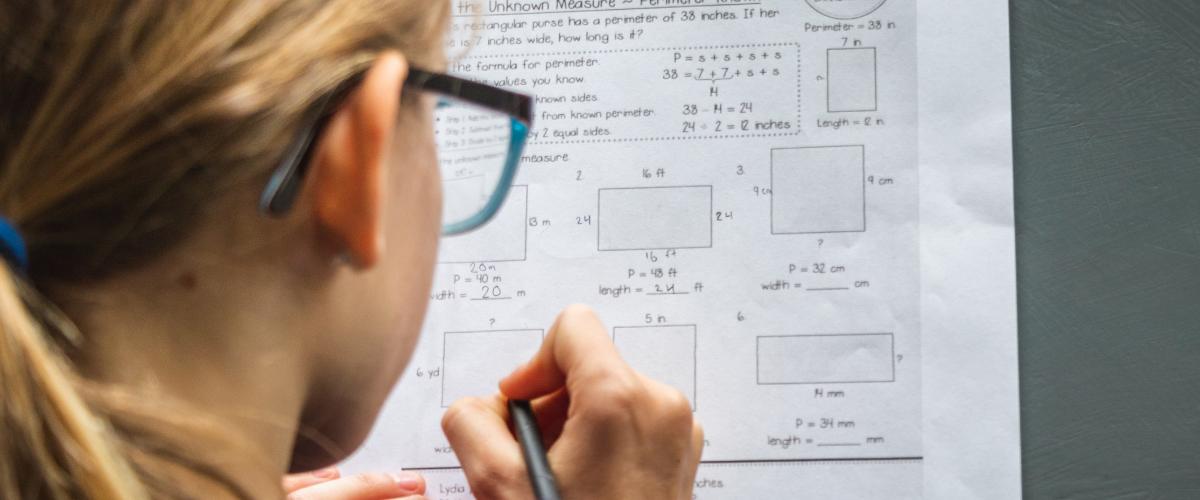Homeschooling math can sometimes seem like a confusing journey into the unknown for both kids and adults.
It can often feel like there are many concepts to teach, many ways of teaching, and countless programs and approaches combined—threatening to turn math homeschooling into a stressful experience.
But homeschooling math doesn't have to be confusing! Discover our top eight tips to help you homeschool math and become a math homeschooling pro.
1. Choose a math curriculum that suits your family
Choosing your curriculum is one of the first steps to homeschooling math. This choice can sometimes seem overwhelming; after all, a quick search for 'math homeschool curriculum' results in a dizzying array of options, all claiming to be the best.
When choosing your curriculum, be sure to research and read the reviews from other homeschoolers. It's also helpful to talk to others who homeschool in your area. Sites like Cathy Duffy Reviews offer in-depth homeschool math curricula reviews.
However, it's important to remember that many opinions exist regarding the best math curriculum in the homeschooling community.
The curriculum that's best for your family depends on many factors, including your children's learning style, your approach to homeschooling, and the level of support you need from the curriculum. Your perfect approach to homeschooling math may differ from that of another homeschooled family.
One of the first choices you should make when finding the best curriculum for your children is the approach you want the curriculum to take. Overall, homeschool math curricula fall into two broad methods that determine how the curriculum is structured:
Spiral
In a spiral-based curriculum, kids are introduced to a topic, idea, or concept that they'll focus on for a short period. They then move on to another concept. Later in the curriculum, they will be exposed to the same concept, review it, and then go deeper to develop their understanding. This spiral repeats throughout the year.
The 'tightness' of the spiral can also vary significantly between curricula. For example, Saxon Math changes concepts most days, whereas Everyday Mathematics focuses on an area of math for a couple of weeks.
Mastery or vertical
In a mastery (or vertical) curriculum, kids are introduced sequentially to concepts and will work on each concept exclusively for a period before moving on, often to a related concept. Examples of mastery curricula include Maths U See, Math Mammoth, and Singapore Math.
While each curriculum is different, both types of curriculum should theoretically cover the same topics to the same level of detail throughout the course. The main differences are the order in which they're taught and the length of time kids spend on each concept before moving on.
One style of curriculum might suit your children while the other does not, so it can be helpful to try some sample lessons for different programs that you can often find on the publisher's website. It helps you to see if the curriculum's approach suits your family before spending money on the entire curriculum.
Did you know that you can also outsource your math teaching to Outschool? Outscshool offers a wide range of classes to help your child through a complete math curriculum aligned with their grade.
For example, you could sign your fifth grader up for this engaging math class or have your 2nd grader join Mrs. Berry-Cherry in her full-curriculum class. You can also find courses aligned with specific curricula, such as Saxon Math, or that help particular math topics.
2. Encourage a positive math mindset
Math, more than any other subject, can crush kids' confidence — but it doesn't have to be that way if you homeschool math in a way that develops a positive math mindset.
In her book 'The Elephant in the Classroom,' Jo Bolar, a leading math educator, and researcher into math mindsets explains that a fundamental problem with math teaching is that parents, students, and educators often believe that only some children can do well in math.
However, multiple research studies have shown that everyone can do well in math and that there is no such thing as a "math" person. So, it's important to ensure that both the conscious and unconscious messages you give about math are positive.
Math often creates all sorts of anxieties for parents, with adults often being quick to admit, "I struggled with math when I was your age," "I hate fractions," or "I just don't see the point of algebra."
However, research has consistently shown that this 'math anxiety' is easily passed on to kids. So, even if you have had a bad experience with math as a kid or believe you 'can't do math,' try to talk and act positively about math to your children.
A key part of developing a positive math mindset is your child's approach to making mistakes.
Mistakes are an essential part of learning, and research shows that mistakes lead to brain growth and new connections, while getting questions 'correct' leads to no brain growth. You should therefore aim to encourage kids to see that mistakes are a positive rather than a 'failure.'
It's also essential that you disassociate math from speed. Children should be encouraged to see that math activities and lessons are about learning, not performing and that learning takes time and effort.
Speed can be counterproductive when people are in stressful situations (such as taking a timed math test). The stress acts as a roadblock to their working memory, and the math facts and understanding they learned and understood cannot be recalled.
3. Foster a conceptual understanding of math
Conceptual understanding, which people sometimes refer to as 'new' math, should be central to your math homeschooling as it has been shown to significantly impact math achievement. It means they understand why math works and how different areas of math are related, rather than just knowing how to do math by following a set of rules or steps.
This blog unpacks what new math is, how it’s different from how most parents learned mathematics, and why you shouldn’t be scared of it.
Having a conceptual understanding means kids are aware of more than just isolated facts and methods and can see the underlying structure of math. Children who have a conceptual understanding of math can spot mistakes, apply their math skills in different situations and make connections between different areas of math.
For example, consider a child with a conceptual understanding of place value and addition. They can likely add a three-digit number to a three-digit number (e.g., 456 + 321 = ?), so it's also likely they can apply this understanding to adding two decimals together (e.g., 3.42 + 6.73 = ?) without being taught new methods or steps.
You can learn more about the importance of conceptual understanding and why 'new' math isn't new in our comprehensive guide to 'new' math. We've also put together a handy blog post that explains some of the key math concepts integral to math homeschooling, including:
- Place value
- Partitioning and decomposition
- Exchanging and regrouping
- Number pairs
- Arrays and area models
If teaching math conceptually seems confusing, then Outschool can help! In addition to offering online math tutoring, Outschool has hundreds of different math classes that allow your kids to develop a conceptual understanding of math alongside other children their age.
4. Use math in the real world
One of the biggest advantages of homeschooling math is that you can teach math in the 'real world.' We all use math every day. It doesn't have to be a 'lesson' or 'teachable moment' every time math is used, so articulating and talking about math can help kids develop their understanding and see how their math skills can be useful in the 'real world.'
You can also actively involve your children in everyday skills and activities that use math.
For example, you could get your 6th grader to apply their percentage skills and calculate how much an item would be with sales tax, or you could enlist your 2nd grader in doubling the ingredients for a recipe. There are also many opportunities to create moments for your children to use math, including:
- Calculate the time it takes to cook a meal or when their favorite movie will end based on its duration.
- Regularly measure the heights of their siblings, recording how tall they are alongside how much they have grown.
- Working out how many weeks remain until their birthday or a vacation.
- Check if you received the correct change from the shop.
- Measure the dimensions of a room with a tape measure and calculate the area for some new flooring.
- Use the scales in the produce department of a grocery store.
- Weigh themselves and their pets and calculate the difference in weight.
- Build a scale model.
- Calculate the diameter of a tree in your backyard.
- Use fractions and percentage skills when cooking or serving up food.
- Plan and run a 'business' such as a lemonade stand or yard sale.
In addition to drawing attention to math in the 'real world,' you may also want to explain to your children that they might not always come across every problem or question they face in a math exercise in the real world.
However, all their math learning is still really valuable as it develops their ability to think mathematically and become 'math detectives,' ultimately building their confidence and math skills.
5. Make math fun
Homeschool math can be lots of fun, especially if you play games involving math or include activities like cooking and arts and crafts in your math teaching.
You can, of course, buy and play lots of specific math games, but you can also create your own games.
For example, you could put a fun math twist on 'Rock, Paper, Scissors' by following the steps below to play "Math, Paper, Scissors:
- Both start with your hands behind your back.
- Call out 'Math, Paper, Scissors, Shoot' and then both put out a number of fingers.
- Race to shout out the total number of fingers (so if you put out 3 and your child 4, you'd call out 7); the first person to call out the correct total wins a point.
- Repeat, and see who can get the most points within 2 minutes.
- You can adapt the game to different ages. For example, you could use both hands or multiply the fingers together rather than add them. You could also total the fingers and take them away from 100, or multiply them by 20/50/75, etc.
Another way to help make math fun for your kids is to sign them up for one of Outschool's engaging Math Clubs, where they can play games and explore the joy of math alongside an expert Outschool teacher and other kids their age.
6. Use models and manipulatives
Encouraging kids to use a mixture of hands-on manipulatives alongside models and images has improved math performance significantly. But what exactly are manipulatives?
Manipulatives are hands-on 'concrete' items that kids can touch and move around. These include objects like Base 10 blocks, coins, hundred squares, and other counters.
Models and images are diagrams or pictorial representations that kids can use to help represent math concepts. Some examples include tape diagrams/bar models, number lines, area models, and part-part-whole diagrams. Discover how to incorporate models into your teaching by checking out Outschool's handy guide to key math models and concepts.
Manipulatives, models, and images help ensure kids have a conceptual understanding of math.
For each new concept or method, they should use manipulatives before developing their knowledge and use diagrams or pictures before moving to completely abstract forms or representations.
7. Develop fluency
When you homeschool math, work to ensure your children have accurate and efficient methods for solving math problems. This extends beyond simply 'knowing' maths — kids who are truly fluent in math can select the most appropriate method for the task and use it efficiently with an understanding of why the method works.
Of course, as part of developing their fluency, children should also be encouraged to automatically recall key math facts — for example, their number bonds to 10 and their multiplication facts up to 12 x 12.
However, kids should develop this automatic recall by having a conceptual understanding of math.
You can find hundreds of online math classes on Outschool that will help your child develop fluency in math facts in an engaging way that supports their conceptual understanding.
8. Put problem-solving and reasoning at the center
Problem-solving and reasoning are key math skills that should be central to your teaching when you homeschool math. These skills go hand in hand with each other, empowering kids to extend and apply their math knowledge.
Problem-solving in math means kids can apply their knowledge and skills to answer unfamiliar problems. For example, a 6th grader should be able to use their knowledge of percentages to determine how much a pair of $60 pants is if they are on sale for 40% off.
Reasoning is the glue that bonds kids' mathematical skills together. Reasoning helps create a connection between fluency and problem-solving and allows children to use their fluency to make connections between areas of math and solve problems.
In one of our recent blog posts, we explore the power of reasoning and how you can develop it when homeschooling math.
You don't have to face homeschooling math alone!
Why not enlist the support of an expert Outschool teacher to support your math teaching and help your kids become confident mathematicians? Outschool offers a wide range of math support, from private tutoring and math camps to classes that cover the entire math curriculum.


.svg)
.svg)







